Related Research Articles

Whaling is the hunting of whales for their usable products such as meat and blubber, which can be turned into a type of oil that was important in the Industrial Revolution. Whaling was practiced as an organized industry as early as 875 AD. By the 16th century, it had become the principal industry in the Basque coastal regions of Spain and France. The whaling industry spread throughout the world and became very profitable in terms of trade and resources. Some regions of the world's oceans, along the animals' migration routes, had a particularly dense whale population and became targets for large concentrations of whaling ships, and the industry continued to grow well into the 20th century. The depletion of some whale species to near extinction led to the banning of whaling in many countries by 1969 and to an international cessation of whaling as an industry in the late 1980s.
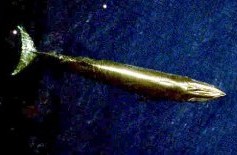
Bryde's whale, or the Bryde's whale complex, putatively comprises three species of rorqual and maybe four. The "complex" means the number and classification remains unclear because of a lack of definitive information and research. The common Bryde's whale is a larger form that occurs worldwide in warm temperate and tropical waters, and the Sittang or Eden's whale is a smaller form that may be restricted to the Indo-Pacific. Also, a smaller, coastal form of B. brydei is found off southern Africa, and perhaps another form in the Indo-Pacific differs in skull morphology, tentatively referred to as the Indo-Pacific Bryde's whale. The recently described Omura's whale, was formerly thought to be a pygmy form of Bryde's, but is now recognized as a distinct species. Rice's whale, which makes its home solely in the Gulf of Mexico, was once considered a distinct population of Bryde's whale, but in 2021 it was described as a separate species.

The humpback whale is a species of baleen whale. It is a rorqual and is the only species in the genus Megaptera. Adults range in length from 14–17 m (46–56 ft) and weigh up to 40 metric tons. The humpback has a distinctive body shape, with long pectoral fins and tubercles on its head. It is known for breaching and other distinctive surface behaviors, making it popular with whale watchers. Males produce a complex song typically lasting 4 to 33 minutes.

The common minke whale or northern minke whale is a species of minke whale within the suborder of baleen whales.

Whale watching is the practice of observing whales and dolphins (cetaceans) in their natural habitat. Whale watching is mostly a recreational activity, but it can also serve scientific and/or educational purposes. A study prepared for International Fund for Animal Welfare in 2009 estimated that 13 million people went whale watching globally in 2008. Whale watching generates $2.1 billion per annum in tourism revenue worldwide, employing around 13,000 workers. The size and rapid growth of the industry has led to complex and continuing debates with the whaling industry about the best use of whales as a natural resource.
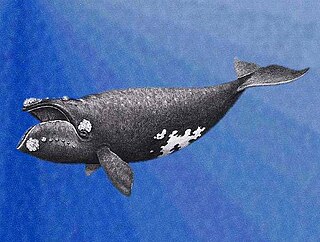
The North Pacific right whale is a very large, thickset baleen whale species that is extremely rare and endangered.
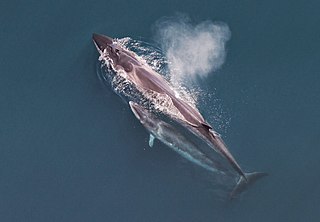
The sei whale is a baleen whale. It is one of ten rorqual species, and the third-largest member after the blue and fin whales. It can grow to 19.5 m (64 ft) in length and weigh as much as 28 t. Two subspecies are recognized: B. b. borealis and B. b. schlegelii. The whale's ventral surface has sporadic markings ranging from light grey to white, and its body is usually dark steel grey in colour. It is among the fastest of all cetaceans, and can reach speeds of up to 50 km/h (31 mph) over short distances.

Aboriginal whaling or indigenous whaling is the hunting of whales by indigenous peoples recognised by either IWC or the hunting is considered as part of indigenous activity by the country. It is permitted under international regulation, but in some countries remains a contentious issue. It is usually considered part of the subsistence economy. In some places, whaling has been superseded by whale watching instead. This article deals with communities that continue to hunt; details about communities that have ended the practice may be found in History of whaling.

Japanese whaling, in terms of active hunting of whales, is estimated by the Japan Whaling Association to have begun around the 12th century. However, Japanese whaling on an industrial scale began around the 1890s when Japan started to participate in the modern whaling industry, at that time an industry in which many countries participated.
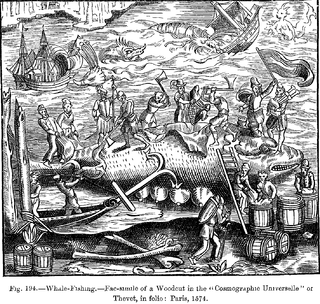
This article discusses the history of whaling from prehistoric times up to the commencement of the International Whaling Commission (IWC) moratorium on commercial whaling in 1986. Whaling has been an important subsistence and economic activity in multiple regions throughout human history. Commercial whaling dramatically reduced in importance during the 19th century due to the development of alternatives to whale oil for lighting, and the collapse in whale populations. Nevertheless, some nations continue to hunt whales even today.
Bequia is the largest island in the Grenadines at 7 square miles (18 km2). It is part of the country of Saint Vincent and the Grenadines and is approximately 15 kilometres (9.3 mi) from the nation's capital, Kingstown, on the main island, Saint Vincent. Bequia means "island of the clouds" in the ancient Arawak. The island's name was also 'Becouya' as part of the Grenadines.

A whaler or whaling ship is a specialized vessel, designed or adapted for whaling: the catching or processing of whales.

Flensing is the removing of the blubber or outer integument of whales, separating it from the animal's meat. Processing the blubber into whale oil was the key step that transformed a whale carcass into a stable, transportable commodity. It was an important part of the history of whaling. The whaling that still continues in the 21st century is both industrial and aboriginal. In aboriginal whaling the blubber is rarely rendered into oil, although it may be eaten as muktuk.
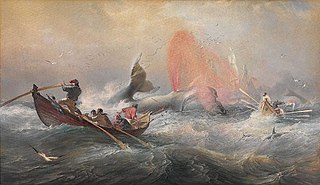
Whaling in Australian waters began in 1791 when five of the 11 ships in the Third Fleet landed their passengers and freight at Sydney Cove and then left Port Jackson to engage in whaling and seal hunting off the coast of Australia and New Zealand. The two main species hunted by such vessels in the early years were right and sperm whales. Humpback, bowhead and other whale species would later be taken.

Whaling was one of the first viable industries established in the Swan River Colony following the 1829 arrival of British settlers to Western Australia. The industry had numerous ups and downs until the last whaling station closed in Albany in 1978.
Whaling in Norway involves hunting of minke whales for use as animal and human food in Norway and for export to Japan. Whale hunting has been a part of Norwegian coastal culture for centuries, and commercial operations targeting the minke whale have occurred since the early 20th century. Some still continue the practice in the modern day, within annual quotas.

The Memorandum of Understanding (MoU) for the Conservation of Cetaceans and their Habitats in the Pacific Island Region is a Multilateral Environmental Memorandum of Understanding concluded under the auspices of the Convention on Migratory Species of Wild Animals (CMS), also known as the Bonn Convention, and in collaboration with the Pacific Regional Environment Programme (SPREP). The MoU provides an international framework for coordinated conservation efforts to improve the conservation status of the Pacific Islands Cetaceans and came into effect on 15 September 2006.

Whale watching in New Zealand is predominantly centred around the areas of Kaikōura and the Hauraki Gulf. Known as the 'whale capital', Kaikōura is a world-famous whale watching site, in particular for sperm whales which is currently the most abundant of large whales in New Zealand waters. The Hauraki Gulf Marine Park is also a significant whale watching area with a resident population of Bryde's Whales commonly viewed alongside other cetaceans Common Dolphins, Bottlenose Dolphins and Orca. Whale watching is also offered in other locations, often as eco-tours and in conjunction with dolphin watching. Land-based whale watching from New Zealand's last whaling station, which closed in 1964, is undertaken for scientific purposes, mostly by ex-whalers.

Russian whaling has been conducted by native peoples in the Chukotka region of Russia since at least 4,000 years ago by native Yupik and Chukchi people, but commercial whaling did not begin until the mid-19th century, when companies based in Finland sent out vessels to the Pacific. It was not until 1932 that modern pelagic whaling began to take off with the purchase of an American cargo ship which was renamed the Aleut, which was the only Soviet factory ship until World War II. After the war, with the need for a stronger Soviet economy and rapid industrialization of the country during the 1940s and 1950s, Soviet whaling took off and became a truly global industry. The first Soviet whalers reached the Antarctic during the 1946–47 season with the factory ship Slava and then underwent a rapid expansion during the late 1950s in which 5 new fleets were added within a 4-year span: Sovetskaya Ukraina in 1959, Yuriy Dolgorukiy in 1960, and Sovetskaya Rossiya in 1961 for the Antarctic, and finally two large fleets in 1963 for the North Pacific. Thus, by the early 1960s Soviet whaling had truly become a global industry, operating in every ocean except the North Atlantic and undertaking voyages that could last as long as seven months each. From 1964 to 1973, the Soviet Union was considered by some the biggest whaling nation in the world.
Cetaceans form an infra-order of marine mammals. In 2020, approximately 86 species of cetaceans had been identified worldwide. Among these species, at least 35 have been sighted in the wider Caribbean region with very widespread distribution and density variations between areas. Caribbean waters are a preferred breeding site for several species of mysticeti, who live further north the rest of the year. The tucuxi and the boto live at the southern periphery of the Caribbean region in the freshwaters of the Amazon River and surrounding drainage basins.
References
- ↑ Reeves R, et el. Historical occurrence and distribution of humpback whales in the eastern and southern Caribbean Sea, based on data from American whaling logbooks. Journal of Cetacean Research and Management. 3.2 (2001): 124.
- ↑ Romero, A., and Hayford, K. Past and present utilisation of marine mammals in Grenada, West Indies. Journal of Cetacean Research and Management. 2.3 (2000): 223-226.
11°59′12″N61°47′13″W / 11.98667°N 61.78694°W